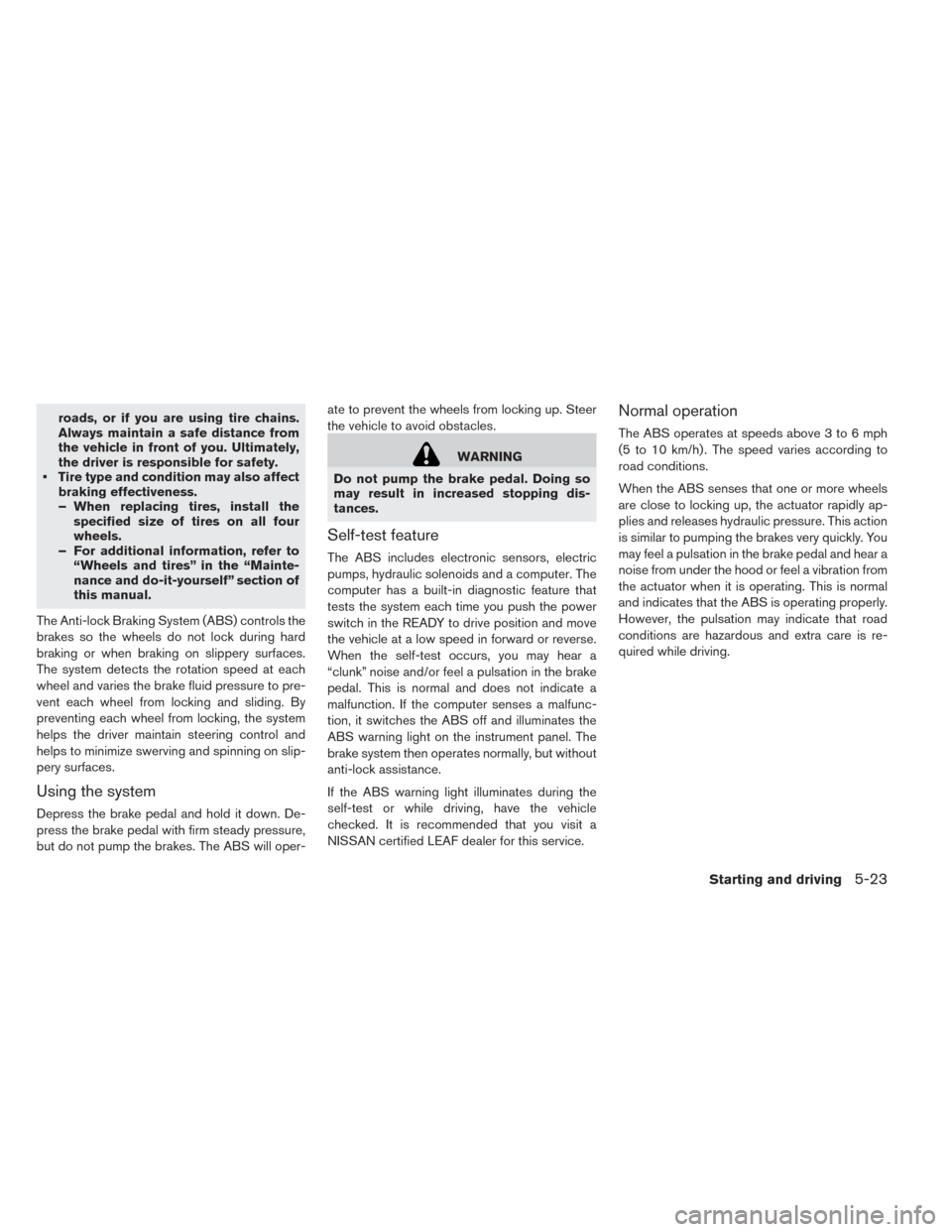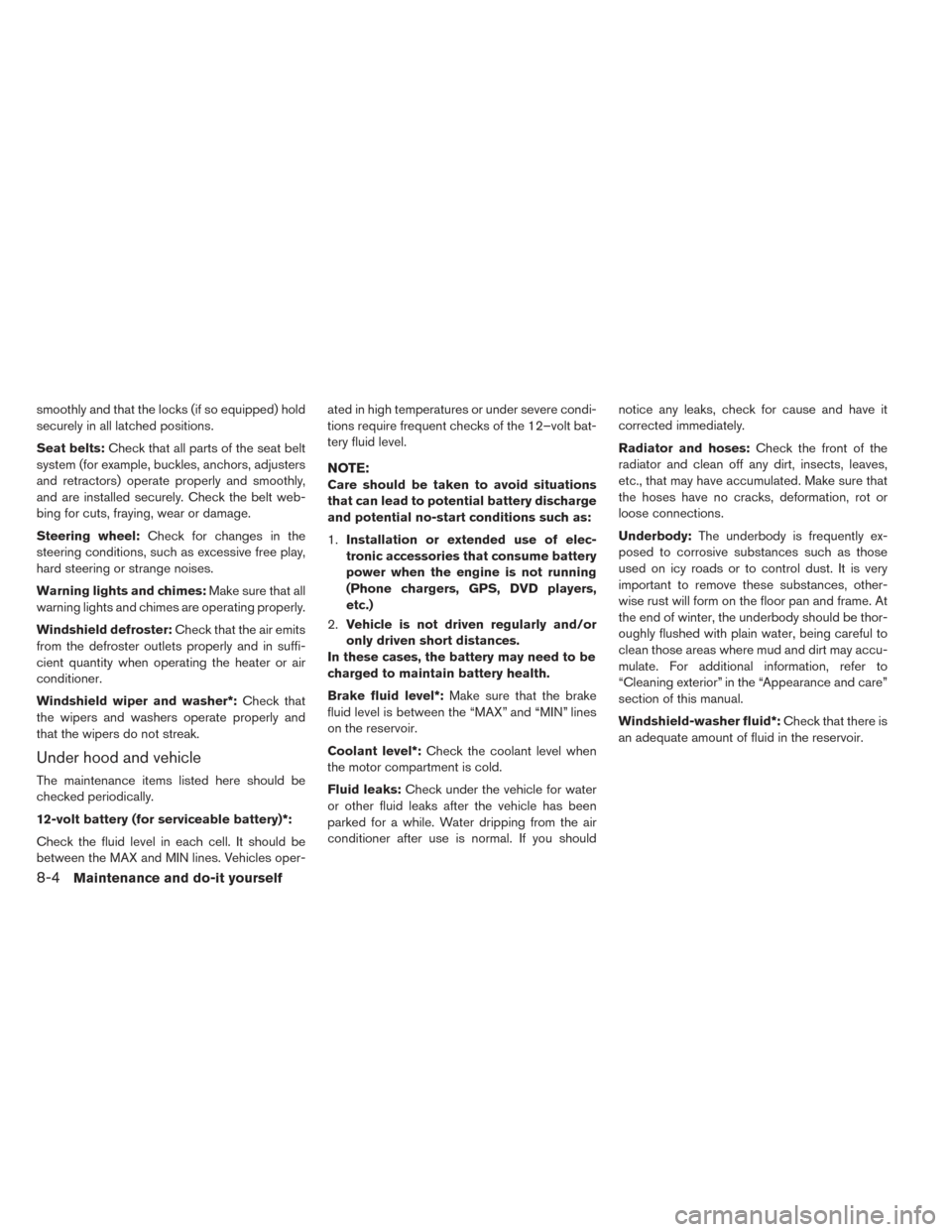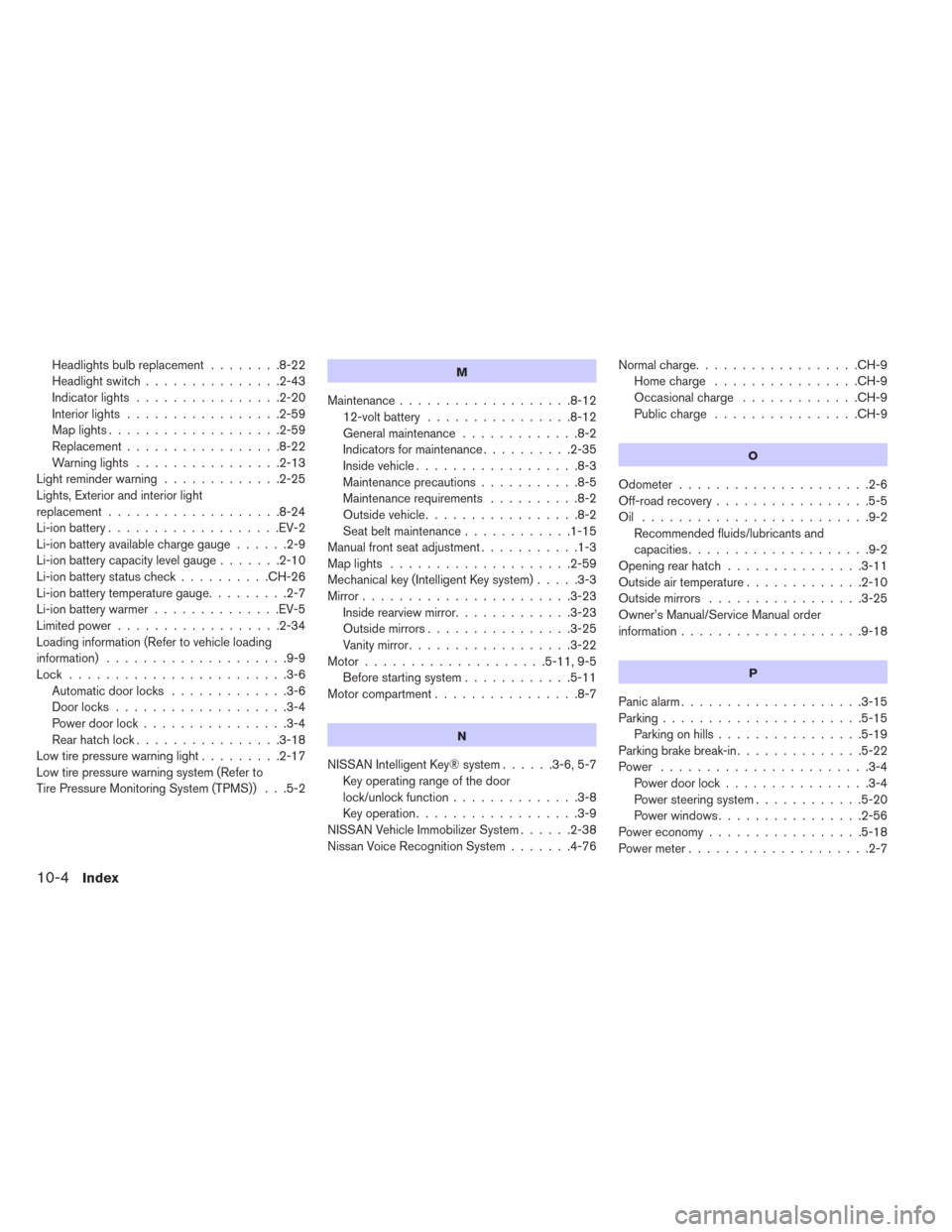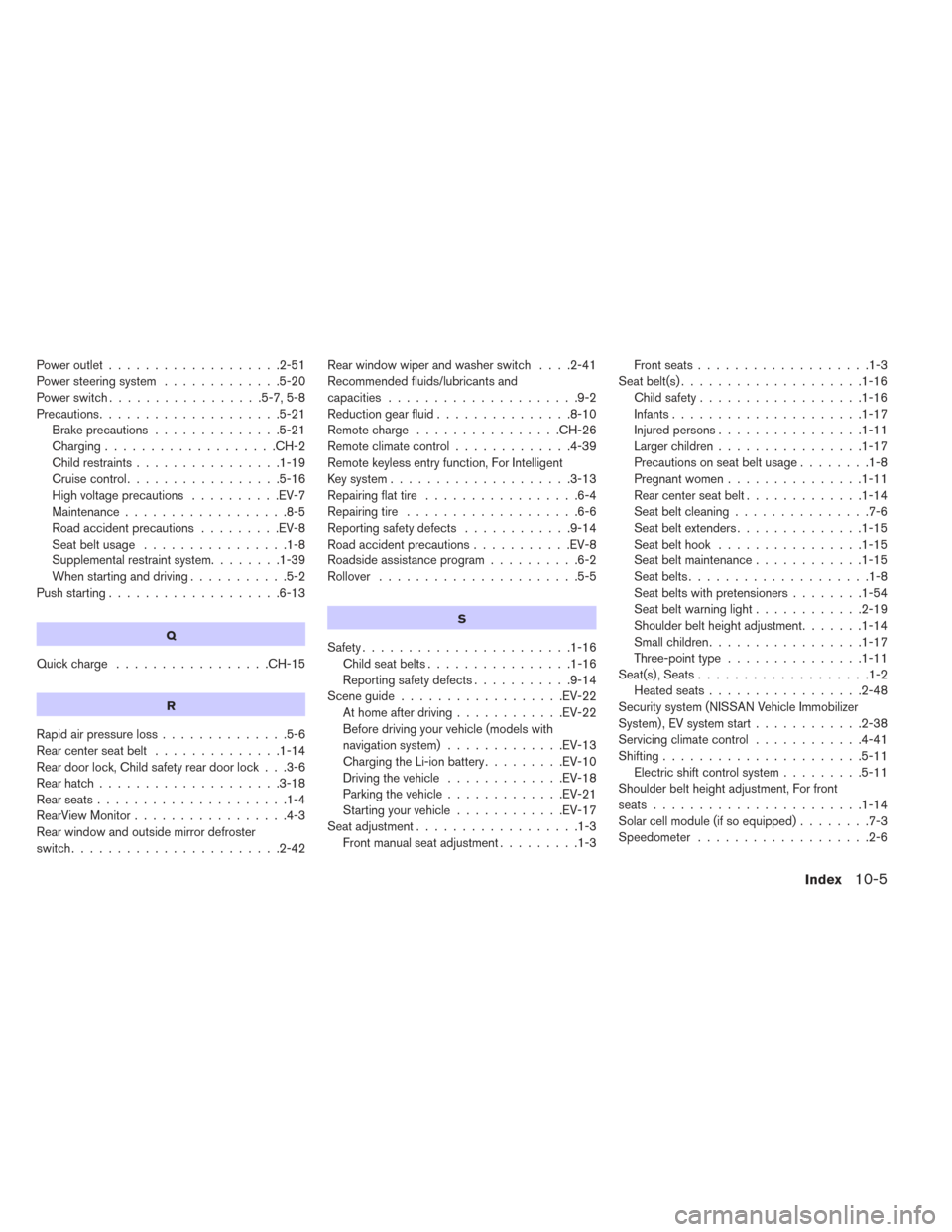2017 NISSAN LEAF power steering fluid
[x] Cancel search: power steering fluidPage 328 of 424

roads, or if you are using tire chains.
Always maintain a safe distance from
the vehicle in front of you. Ultimately,
the driver is responsible for safety.
• Tire type and condition may also affect braking effectiveness.
– When replacing tires, install thespecified size of tires on all four
wheels.
– For additional information, refer to “Wheels and tires” in the “Mainte-
nance and do-it-yourself” section of
this manual.
The Anti-lock Braking System (ABS) controls the
brakes so the wheels do not lock during hard
braking or when braking on slippery surfaces.
The system detects the rotation speed at each
wheel and varies the brake fluid pressure to pre-
vent each wheel from locking and sliding. By
preventing each wheel from locking, the system
helps the driver maintain steering control and
helps to minimize swerving and spinning on slip-
pery surfaces.
Using the system
Depress the brake pedal and hold it down. De-
press the brake pedal with firm steady pressure,
but do not pump the brakes. The ABS will oper- ate to prevent the wheels from locking up. Steer
the vehicle to avoid obstacles.
WARNING
Do not pump the brake pedal. Doing so
may result in increased stopping dis-
tances.
Self-test feature
The ABS includes electronic sensors, electric
pumps, hydraulic solenoids and a computer. The
computer has a built-in diagnostic feature that
tests the system each time you push the power
switch in the READY to drive position and move
the vehicle at a low speed in forward or reverse.
When the self-test occurs, you may hear a
“clunk” noise and/or feel a pulsation in the brake
pedal. This is normal and does not indicate a
malfunction. If the computer senses a malfunc-
tion, it switches the ABS off and illuminates the
ABS warning light on the instrument panel. The
brake system then operates normally, but without
anti-lock assistance.
If the ABS warning light illuminates during the
self-test or while driving, have the vehicle
checked. It is recommended that you visit a
NISSAN certified LEAF dealer for this service.
Normal operation
The ABS operates at speeds above 3 to 6 mph
(5 to 10 km/h) . The speed varies according to
road conditions.
When the ABS senses that one or more wheels
are close to locking up, the actuator rapidly ap-
plies and releases hydraulic pressure. This action
is similar to pumping the brakes very quickly. You
may feel a pulsation in the brake pedal and hear a
noise from under the hood or feel a vibration from
the actuator when it is operating. This is normal
and indicates that the ABS is operating properly.
However, the pulsation may indicate that road
conditions are hazardous and extra care is re-
quired while driving.
Starting and driving5-23
Page 361 of 424

smoothly and that the locks (if so equipped) hold
securely in all latched positions.
Seat belts:Check that all parts of the seat belt
system (for example, buckles, anchors, adjusters
and retractors) operate properly and smoothly,
and are installed securely. Check the belt web-
bing for cuts, fraying, wear or damage.
Steering wheel: Check for changes in the
steering conditions, such as excessive free play,
hard steering or strange noises.
Warning lights and chimes: Make sure that all
warning lights and chimes are operating properly.
Windshield defroster: Check that the air emits
from the defroster outlets properly and in suffi-
cient quantity when operating the heater or air
conditioner.
Windshield wiper and washer*: Check that
the wipers and washers operate properly and
that the wipers do not streak.
Under hood and vehicle
The maintenance items listed here should be
checked periodically.
12-volt battery (for serviceable battery)*:
Check the fluid level in each cell. It should be
between the MAX and MIN lines. Vehicles oper- ated in high temperatures or under severe condi-
tions require frequent checks of the 12–volt bat-
tery fluid level.
NOTE:
Care should be taken to avoid situations
that can lead to potential battery discharge
and potential no-start conditions such as:
1.
Installation or extended use of elec-
tronic accessories that consume battery
power when the engine is not running
(Phone chargers, GPS, DVD players,
etc.)
2. Vehicle is not driven regularly and/or
only driven short distances.
In these cases, the battery may need to be
charged to maintain battery health.
Brake fluid level*: Make sure that the brake
fluid level is between the “MAX” and “MIN” lines
on the reservoir.
Coolant level*: Check the coolant level when
the motor compartment is cold.
Fluid leaks: Check under the vehicle for water
or other fluid leaks after the vehicle has been
parked for a while. Water dripping from the air
conditioner after use is normal. If you should notice any leaks, check for cause and have it
corrected immediately.
Radiator and hoses:
Check the front of the
radiator and clean off any dirt, insects, leaves,
etc., that may have accumulated. Make sure that
the hoses have no cracks, deformation, rot or
loose connections.
Underbody: The underbody is frequently ex-
posed to corrosive substances such as those
used on icy roads or to control dust. It is very
important to remove these substances, other-
wise rust will form on the floor pan and frame. At
the end of winter, the underbody should be thor-
oughly flushed with plain water, being careful to
clean those areas where mud and dirt may accu-
mulate. For additional information, refer to
“Cleaning exterior” in the “Appearance and care”
section of this manual.
Windshield-washer fluid*: Check that there is
an adequate amount of fluid in the reservoir.
8-4Maintenance and do-it yourself
Page 419 of 424

Headlights bulb replacement........8-22
Headlightswitch...............2-43
Indicatorlights ................2-20
Interior lights .................2-59
Maplights...................2-59
Replacement .................8-22
Warninglights ................2-13
Light reminder warning .............2-25
Lights, Exterior and interior light
replacement ...................8-24
Li-ion battery ...................EV-2
Li-ion battery available charge gauge ......2-9
Li-ion battery capacity level gauge .......2-10
Li-ion battery status check ..........CH-26
Li-ion battery temperature gauge .........2-7
Li-ion battery warmer ..............EV-5
Limited power ..................2-34
Loading information (Refer to vehicle loading
information) ....................9-9
Lock ........................3-6
Automatic door locks .............3-6
Door locks ...................3-4
Power door lock ................3-4
Rearhatchlock................3-18
Low tire pressure warning light .........2-17
Low tire pressure warning system (Refer to
Tire Pressure Monitoring System (TPMS)) . . .5-2M
Maintenance...................8-12 12-volt battery ................8-12
General maintenance .............8-2
Indicators for maintenance ..........2-35
Insidevehicle..................8-3
Maintenanceprecautions...........8-5
Maintenance requirements ..........8-2
Outside vehicle .................8-2
Seat belt maintenance ............1-15
Manual front seat adjustment ...........1-3
Maplights ....................2-59
Mechanical key (Intelligent Key system) .....3-3
Mirror .......................3-23
Inside rearview mirror.............3-23
Outside mirrors ................3-25
Vanity mirror ..................3-22
Motor....................5-11,9-5 Before starting system ............5-11
Motor compartment ................8-7
N
NISSAN Intelligent Key® system ......3-6,5-7
Key operating range of the door
lock/unlock function ..............3-8
Key operation ..................3-9
NISSAN Vehicle Immobilizer System ......2-38
Nissan Voice Recognition System .......4-76Normal charge..................CH-9
Home charge ................CH-9
Occasional charge .............CH-9
Publiccharge ................CH-9
O
Odometer .....................2-6
Off-road recovery .................5-5
Oil .........................9-2 Recommended fluids/lubricants and
capacities ....................9-2
Openingrearhatch...............3-11
Outside air temperature .............2-10
Outside mirrors .................3-25
Owner’s Manual/Service Manual order
information ....................9-18
P
Panic alarm....................3-15
Parking ......................5-15
Parking on hills ................5-19
Parking brake break-in ..............5-22
Power .......................3-4 Power door lock ................3-4
Power steering system ............5-20
Power windows ................2-56
Powereconomy.................5-18
Powermeter....................2-7
10-4Index
Page 420 of 424

Poweroutlet...................2-51
Power steering system.............5-20
Powerswitch.................5-7,5-8
Precautions....................5-21 Brake precautions ..............5-21
Charging...................CH-2
Child restraints ................1-19
Cruisecontrol.................5-16
High voltage precautions ..........EV-7
Maintenance ..................8-5
Road accident precautions .........EV-8
Seatbeltusage ................1-8
Supplemental restraint system ........1-39
When starting and driving ...........5-2
Push starting ...................6-13
Q
Quickcharge .................CH-15
R
Rapidairpressureloss..............5-6
Rearcenterseatbelt ..............1-14
Rear door lock, Child safety rear door lock . . .3-6
Rear hatch....................3-18
Rearseats.....................1-4
RearView Monitor .................4-3
Rear window and outside mirror defroster
switch .......................2-42 Rear window wiper and washer switch
....2-41
Recommended fluids/lubricants and
capacities .....................9-2
Reduction gear fluid ...............8-10
Remote charge ................CH-26
Remote climate control .............4-39
Remote keyless entry function, For Intelligent
Key system ....................3-13
Repairing flat tire .................6-4
Repairing tire ...................6-6
Reporting safety defects ............9-14
Road accident precautions ...........EV-8
Roadside assistance program ..........6-2
Rollover ......................5-5
S
Safety.......................1-16 Childseatbelts................1-16
Reporting safety defects ...........9-14
Sceneguide..................EV-22 At home after driving ............EV-22
Before driving your vehicle (models with
navigation system) .............EV-13
Charging the Li-ion battery .........EV-10
Driving the vehicle .............EV-18
Parking the vehicle .............EV-21
Starting your vehicle ............EV-17
Seat adjustment ..................1-3
Front manual seat adjustment .........1-3Front seats
...................1-3
Seat belt(s) ....................1-16
Child safety ..................1-16
Infants.....................1-17
Injured persons ................1-11
Larger children ................1-17
Precautions on seat belt usage ........1-8
Pregnant women ...............1-11
Rearcenterseatbelt.............1-14
Seat belt cleaning ...............7-6
Seat belt extenders ..............1-15
Seat belt hook ................1-15
Seat belt maintenance ............1-15
Seatbelts....................1-8
Seatbeltswithpretensioners........1-54
Seatbeltwarninglight............2-19
Shoulder belt height adjustment .......1-14
Small children .................1-17
Three-pointtype...............1-11
Seat(s) , Seats ...................1-2
Heatedseats.................2-48
Security system (NISSAN Vehicle Immobilizer
System) , EV system start ............2-38
Servicing climate control ............4-41
Shifting ......................5-11
Electric shift control system .........5-11
Shoulder belt height adjustment, For front
seats .......................1-14
Solar cell module (if so equipped) ........7-3
Speedometer ...................2-6
Index10-5